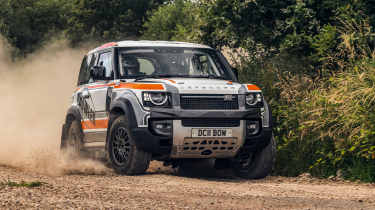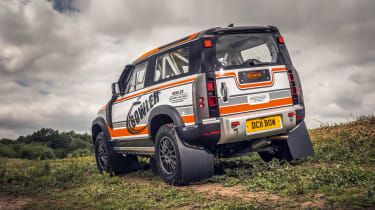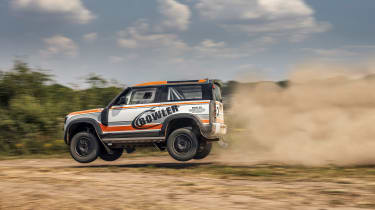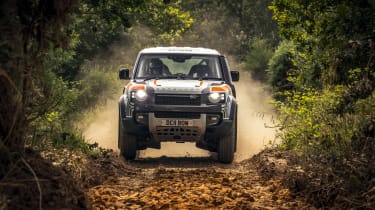Bowler Defender Challenge 2022 review – the ultimate off-road toy?
Off-road rallying is motorsport at its most extreme, and the Bowler Defender is one way to travel absurdly quickly across the toughest terrain. We strap ourselves in…
If you lie awake at night imagining a 200mph blur of Armco and trees in your peripheral vision as you hammer down towards the first chicane on the Mulsanne straight, if you doodle sports prototypes when you should be making notes in Zoom calls, then you probably know where you’d start. Something like a Radical would be the logical first stride down a path to Le Mans. Similarly, karting then Formula Ford are the well-worn initial step on the staircase to Formula 1.
But what if you dream of dunes and day-long stints at the wheel in the Dakar? What if the BRX Hunter on the previous pages is your idea of the pinnacle of motorsport? Well, you probably want to start with something like the Defender Challenge. The seven-round, single-make championship takes in traditional rallies like the Trackrod as well as more extreme hill rallies.
> Bamford X Bishops Heritage Limited Edition Range Rover 2022 review
I took part in the Scottish Borders Hill Rally back in 2014 and I’ve honestly never laughed so much while also trying to be competitive. The combination of flat-out fire roads and technical sections that tested traction (and my nerves) to the limit during daylight and darkness felt like a real adventure.
More reviews
In-depth reviews
Long term tests
Reviews
- Land Rover Defender Octa 2025 review – so much more than a ‘Defender SV’
- Land Rover Classic Defender V8 2024 review – driving a £190,000 Land Rover
- Land Rover Defender 130 V8 2024 review – an exercise in excess
- Bowler Defender 2023 review
- Land Rover Defender V8 2021 review – a G63 rival, or something more subtle?
- Land Rover Defender 90 X P400 2020 review – heart over head
That was in the old Defender Challenge car, which was… interesting to drive. Closely based on a standard 2.2 turbodiesel Defender 90 it was, unsurprisingly, incredibly capable over the rough stuff. But speed could be scary and slides needed to be kept very neat otherwise you’d almost certainly end up in the mother of all tank-slappers before spinning and possibly even rolling. This new Defender Challenge car is rather different.
As with the previous generation, it has been built by Bowler, famous for creating such rally raid icons as the Wildcat and Nemesis. Sadly the company’s founder, Drew Bowler, died in 2016 and I was a little worried that when Jaguar Land Rover bought Bowler in 2019 it would become a rather watered-down wing of the larger company. Thankfully that doesn’t seem to be the case and there are some familiar faces at the launch of the new car, all of them keen to stress that Bowler is still very independent but now has valuable access to some of the test and development facilities of JLR.
They’ve clearly put the facilities to good use too, because although at first glance the Challenge car looks very like a standard new Defender with some stickers and extra ride height (25mm if you’re interested), a huge amount has changed. Open the driver’s door and before you even get in you might notice that a 71mm portion has been taken off the bottom of the doors to allow the 6mm aluminium underbody protection to wrap around the sills. There is also more bracing under the car, the front and rear subframes have been strengthened, the suspension turrets are braced, there are new mounts for the gearbox and engine and there is obviously a full FIA roll cage inside. Extra lights have been integrated front and rear, Bowler’s 18in wheels are 25 per cent stronger, there are bespoke Fox dampers, there is increased cooling capability and to crown it all there is the most impressive row of windscreen washer jets I have ever seen.
When you tally up the weight savings from stripping out the original vehicle and then putting in a lot of additional metalwork, the end result is a car that weighs about the same as the standard road car. The 2-litre Ingenium petrol four-cylinder and the eight-speed auto both remain largely untouched, so there is 296bhp and 295lb ft of torque on offer. It’s not the most exhilarating of competition drivetrains, but it equates to a reasonably brisk 0-60mph time of around 6.7 seconds.
Sitting up high but clamped in place by a bucket seat and harness is a strange feeling at first. In fact the whole ambience of the cabin is curious because it is stripped out and bare but also has quite a bit of the dash architecture still in place, including the large touchscreen. With the air- con on, it certainly feels like a much more comfortable and spacious place to spend time in than the old version.
One of the changes you might not notice initially is that Bowler has moved the whole dash further into the cabin to both allow for the extra bracing behind and also place the gear selector more conveniently for the driver. Not that you need to use it once you’ve put the Defender in drive because there is a single WRC-style paddle behind the steering wheel that you can use to change gear – push away to go down a gear, pull it towards you to go up – or you can simply leave the ’box to shift itself, leaving you to concentrate on the terrain ahead. The latter is an option that will sound like heresy to some but I can imagine it would be very welcome for those with a lot to get used to in their first events.
There is certainly a good variety of terrain on the test track that has been set out by Bowler: everything from tarmac to deep ruts and some jumps. You feel quite remote from the ground that you’re covering but the more time you spend behind the wheel the more you learn to trust the Defender and understand that you simply don’t need to feel a large amount of what is passing beneath you. You lean into the ruts and you can take huge liberties with a lot of the apexes. The jumps highlight just what a good job the dampers are doing because the landings are as well controlled as a gymnast sitting down on a sofa. Even when the car takes a little bit of angle in the air at something approaching 70mph everything remains calm when the tyres come back to earth.
Through a quick but blind left-hander on the tarmac, the Defender slides a little more with every lap, but as you load up the suspension you can feel that the support is there. It all stays remarkably flat, and even when the oversteer builds there is the speed in the steering and the response from the chassis to comfortably catch the resulting slide. Liberties can be taken and although you need to be patient at times and allow leeway for that weight and ride height, you can really chuck it around.
It shouldn’t be that much of a surprise that the new Defender Challenge car is so good to drive. When I drove the standard 110 out in Africa last year, it was a willing accomplice pushing hard on the sand and gravel tracks. A regular 90 with this drivetrain costs from just over £50,000, so it’s no surprise that with all the work that’s gone into it you’ll need nearly twice that for this Bowler version. The price does also include entry to and event support on the Defender Challenge Championship, however, and I think this is a vehicle that could take you on adventures beyond that in the years after – maybe even ones that would see you lining up alongside the likes of the BRX. While the introductory cold, muddy service parks of England, Wales and Scotland might seem a world away from the hot, sandy bivouacs of the Dakar, from my experience they will still feel like a big old adventure for a first rung on the ladder.
Bowler Defender Challenge specs
| Engine | In-line 4-cyl, 1984cc, turbo |
| Power | 296bhp @ 5500rpm |
| Torque | 295lb ft @ 1500-4500rpm |
| Weight | c2200kg |
| Power-to-weight | 137bhp/ton |
| 0-60mph | 6.7sec |
| Top speed | 120mph (est) |
| Basic price | £99,500 (see text) |







